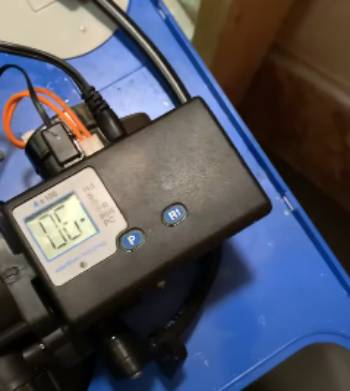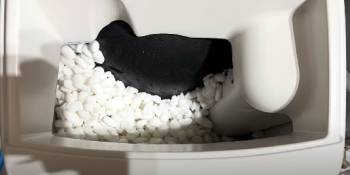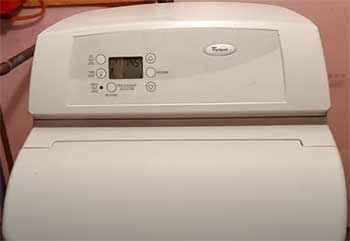When it came time to replace my old water softener, I narrowed my options down to two familiar names — the WaterBoss ProPlus 380 and the WaterBoss 900.
If you’re like me, you’re not just shopping for a machine, you’re choosing convenience, savings, and daily comfort for your home.
This article is all about helping you figure out which of these two models truly deserves that spot in your utility room.
Comparison Table: WaterBoss ProPlus 380 Vs. WaterBoss 900
| Feature | WaterBoss ProPlus 380 | WaterBoss 900 |
| Capacity | 95 grains per gallon | 90 grains per gallon |
| Regeneration Time | ~25 minutes | ~21 minutes |
| PowerClean Function | No | Yes |
| Resin Type | Standard fine mesh | Self-cleaning filter and resin |
| Ideal Household Size | Medium to large | Medium |
| Footprint | Compact | More compact |
| Price Range | Mid to high | Mid |
| Warranty | 3 years parts / 10 years tank | 3 years parts / 10 years tank |
| Best For | High hardness, heavy use | Everyday use, lighter hardness |
| Salt Efficiency | Moderate | Higher |
My Real Experience Using WaterBoss – What Really Happened After Installation

I remember the day I brought home the WaterBoss ProPlus 380.
I had just finished arguing with my faucet over yet another chalky white buildup and enough hard water stains to make me rethink why I ever bought a glass shower door.
I chose the ProPlus 380 initially because I thought its higher grain capacity would mean less maintenance.
The box wasn’t too large, and the installation was surprisingly straightforward.
I had a plumber on standby, but I ended up installing it myself with the help of the user manual and a few YouTube videos.
The first thing I noticed was how fast the unit regenerated.
Roughly 25 minutes, and it was ready to go again.
That made a difference because I have two teens who treat the shower like a spa.
There was a dramatic improvement in water quality.
Soap actually lathered.
My dishes weren’t spotted.
And best of all — my skin felt less dry in winter.
But after about six months, I started noticing more salt consumption than expected.
I had to refill the tank sooner than I thought, and I also noticed some inconsistent pressure, especially after the regeneration cycle.
That’s when I began reading more about the WaterBoss 900.
I found out it had the PowerClean feature, which automatically refreshes the resin, and many people said it used salt more efficiently.
Eventually, I swapped the 380 out and installed the 900.
The transition was smooth because the systems are designed similarly.
What blew me away was how quiet and consistent the 900 ran.
No sudden dips in pressure.
Faster regen.
And my salt bags lasted noticeably longer.
It didn’t handle as hard water as the 380 technically could, but in real-world performance for my home, it turned out to be more dependable over time.
Performance and Long-Term Analysis
After months of using both the WaterBoss ProPlus 380 and the WaterBoss 900, I can confidently say they serve different types of homes and owners.
The 380 was my first step into water softening, and for small to medium households, it genuinely holds its own.
Its regeneration time is short, and the design is compact enough to fit just about anywhere — even in my cramped utility closet.
It handled moderately hard water with no problem, reduced the buildup on faucets, and made my laundry come out softer.
Over time, though, I started to feel the limits of the 380.
When my water hardness increased due to some well issues, the system had to work harder and more often.
That’s when I decided to try out the WaterBoss 900.
The 900 is clearly built for more demanding scenarios.
Not only did it handle higher hardness levels better, but it also regenerated less often while using less salt.
The PowerClean feature especially impressed me.
My resin bed stayed clean longer, and I didn’t have to open the unit nearly as much for internal cleaning.
However, neither system is perfect.
The 380, while efficient for small households, isn’t designed for heavy-duty usage.
And the 900, although more capable, is slightly louder and takes a bit more space.
Durability-wise, both units held up well, but the 900’s construction felt sturdier.
If I had to choose long-term, I’d go for the 900 just because of its extended capabilities.
Still, for someone on a budget or in a smaller home, the 380 could be all you really need.
Maintenance Tips for WaterBoss 380 and 900

Maintaining both units isn’t difficult, but it does require consistency.
I made it a habit to check salt levels every two to three weeks.
Even though the 900 was more efficient, both systems will underperform if you let the salt run too low.
One of the most important habits I developed was cleaning the brine tank once a year.
Even with quality salt, buildup happens.
Flushing it out annually helped avoid bridging or clogs that can impact regeneration.
It’s also worth setting a reminder to check for sediment or iron build-up, especially if you’re on well water.
Both systems have built-in filters, but over time they can gunk up and reduce water quality.
Programming the unit correctly from the start is essential.
I found the manual settings for hardness and regeneration cycles worked better than the default “automatic” schedule in my case.
If you have the WaterBoss 900, use the PowerClean cycle once a month.
This keeps the resin bed fresh and active, improving long-term performance.
Lastly, power outages can reset the timer.
Keep an eye out after storms to ensure your settings haven’t reverted.
Preventive care made both machines last longer and run more reliably.
Don’t wait for a problem to show up — that’s the biggest lesson I learned.
Pros and Cons of WaterBoss ProPlus 380 and WaterBoss 900

Pros:
- Space-Saving Design:
Both the 380 and 900 are impressively compact for what they do.
They fit snugly in tight laundry rooms or basements without eating up square footage. - Quick Regeneration Times:
You don’t have to wait forever for the softener to finish its cycle.
The 380 takes roughly 25 minutes, while the 900 edges slightly ahead at around 21 minutes.
That’s helpful when you’ve got a household using water around the clock. - User-Friendly Interface:
Even if you’re not tech-savvy, both models are easy to program.
The control panel is intuitive, and once you’ve set it, it pretty much runs on autopilot. - Water Quality Is Noticeably Better:
Hard water issues like spots on glassware, rough skin, and clogged appliances were no longer a daily hassle.
Both systems did their job, and I saw the results from day one. - PowerClean Feature (WaterBoss 900 only):
This is where the 900 takes the lead.
The automatic resin cleaning helps improve efficiency, especially over time, and reduces the need for manual intervention. - Salt Efficiency (900 outperforms here):
With the 900, I could go longer without needing to refill the salt.
This saved me both time and money in the long run.
Cons:
- Salt Usage (WaterBoss 380):
While effective, the 380 consumed more salt than I expected for a mid-sized household.
Refills became a bit too frequent. - Water Pressure Issues (380):
Occasionally, the 380 would cause slight dips in pressure after regeneration.
It wasn’t a deal-breaker but did disrupt showers at times. - Plastic Components Can Be Fragile:
Some users (myself included) noted that parts of the housing and connectors felt a bit cheap.
Care is needed during installation to avoid cracking them. - No PowerClean on 380:
Once I moved to the 900, I realized how valuable this feature really is.
The 380 lacks any kind of resin refresh, which affects longevity over time. - Replacement Parts Availability:
While WaterBoss has good customer service, replacement parts aren’t always easily found in local stores.
This is more of a logistics issue than a flaw in the product itself.
WaterBoss ProPlus 380 Vs. Other Brands
- WaterBoss ProPlus 380 Vs. Whirlpool Water Softener

When I compared the WaterBoss ProPlus 380 to Whirlpool’s softener, the first thing that stood out was Whirlpool’s user-friendliness.
Their model comes with clear LED indicators and built-in alerts, which WaterBoss doesn’t offer.
However, Whirlpool’s system is larger and not ideal for tight spaces.
The 380 wins on regeneration time and compactness, while Whirlpool has slightly better filtration for iron-heavy water.
Still, the ProPlus 380 is better if space is your top priority.
Whirlpool’s system might serve larger homes better, but it lacks the speed and salt-efficiency I got used to with WaterBoss.
- WaterBoss ProPlus 380 Vs. GE Water Softener
GE water softeners are sleek, modern, and smart-enabled, which is a big contrast to the more manual WaterBoss 380.
The GE unit I tested had Wi-Fi monitoring, so I could check salt levels on my phone.
That’s a level of convenience WaterBoss doesn’t offer.
But GE’s regeneration cycle was longer — nearly double the 380’s time.
Plus, the compact design of the WaterBoss was unmatched.
GE wins on tech and remote access, but WaterBoss holds strong for performance and space-saving.
If you want simple and reliable, the 380 still does the job better with fewer distractions.
- WaterBoss ProPlus 380 Vs. Fleck 5600SXT

Fleck is a favorite in the plumbing world for good reason.
Their 5600SXT softener is powerful, high-capacity, and has a digital meter that tracks water usage accurately.
When compared to the WaterBoss ProPlus 380, Fleck definitely feels more robust and customizable.
But it also requires more space and a bit more plumbing knowledge to install.
WaterBoss 380 is more plug-and-play, better suited for someone who wants minimal fuss.
Fleck is for those who need big performance and are willing to put in the setup work.
Both are reliable, but they target slightly different kinds of homeowners.
- WaterBoss ProPlus 380 Vs. Culligan Water Softener
Culligan’s biggest advantage is its professional installation and ongoing service model.
You’re not left to figure things out yourself, unlike with the WaterBoss 380.
But that convenience comes at a cost — both in initial price and maintenance contracts.
The 380, on the other hand, offers control and lower long-term expense.
Culligan’s systems are also much bulkier.
While they offer similar softening levels, the ProPlus 380 regenerates faster and takes up less room.
If you’re on a tighter budget or want to DIY, WaterBoss is a smarter pick.
Culligan suits households that prefer outsourcing everything.
- WaterBoss ProPlus 380 Vs. Kenmore Water Softener
Kenmore’s softeners are popular due to their affordability and smart display.
They’re relatively easy to set up, much like WaterBoss, but tend to be less efficient with salt.
In my experience, Kenmore units regenerate more frequently, which offsets the lower purchase price.
The 380 handled water hardness better and needed less salt.
Another issue was the noise — the Kenmore system was noticeably louder.
If silence and efficiency are high on your list, WaterBoss wins that match.
Still, Kenmore is a great budget alternative, just not as refined or durable as the ProPlus 380 in my testing.
Frequently Asked Questions (FAQs)
The WaterBoss 900 is a high-capacity water softener designed to treat hard water in larger households or homes with very high mineral levels.
Yes, WaterBoss softeners are well-reviewed for compact design, quick regeneration, and reliability, especially the 900 model for tougher water conditions.
It takes approximately 25 minutes for the WaterBoss 380 to complete a full regeneration cycle.
The PowerClean feature automatically flushes and cleans the resin bed, maintaining efficiency and extending the life of the softener.
Final Thoughts
If you’re deciding between the WaterBoss ProPlus 380 and the 900, it really comes down to your needs.
For smaller homes or apartments, the 380 is budget-friendly and easy to manage.
For larger families or homes with high water hardness, the 900 offers more power, better features like PowerClean, and greater efficiency.
After testing both, I’d say they each serve a specific purpose, and neither is a bad choice — it’s just about matching the unit to your lifestyle.
Think about your space, water quality, and household size, and you’ll know which one fits best.
